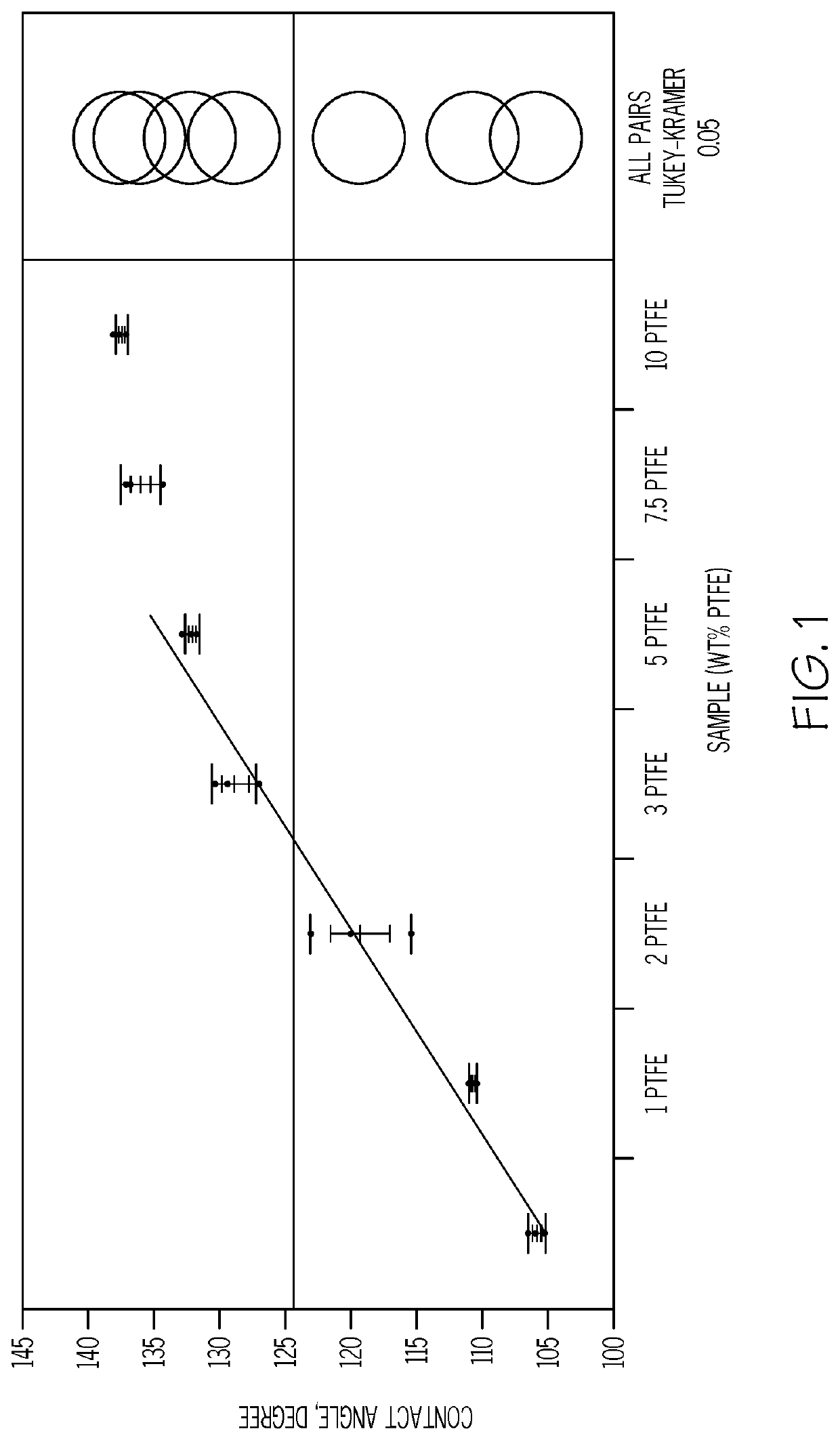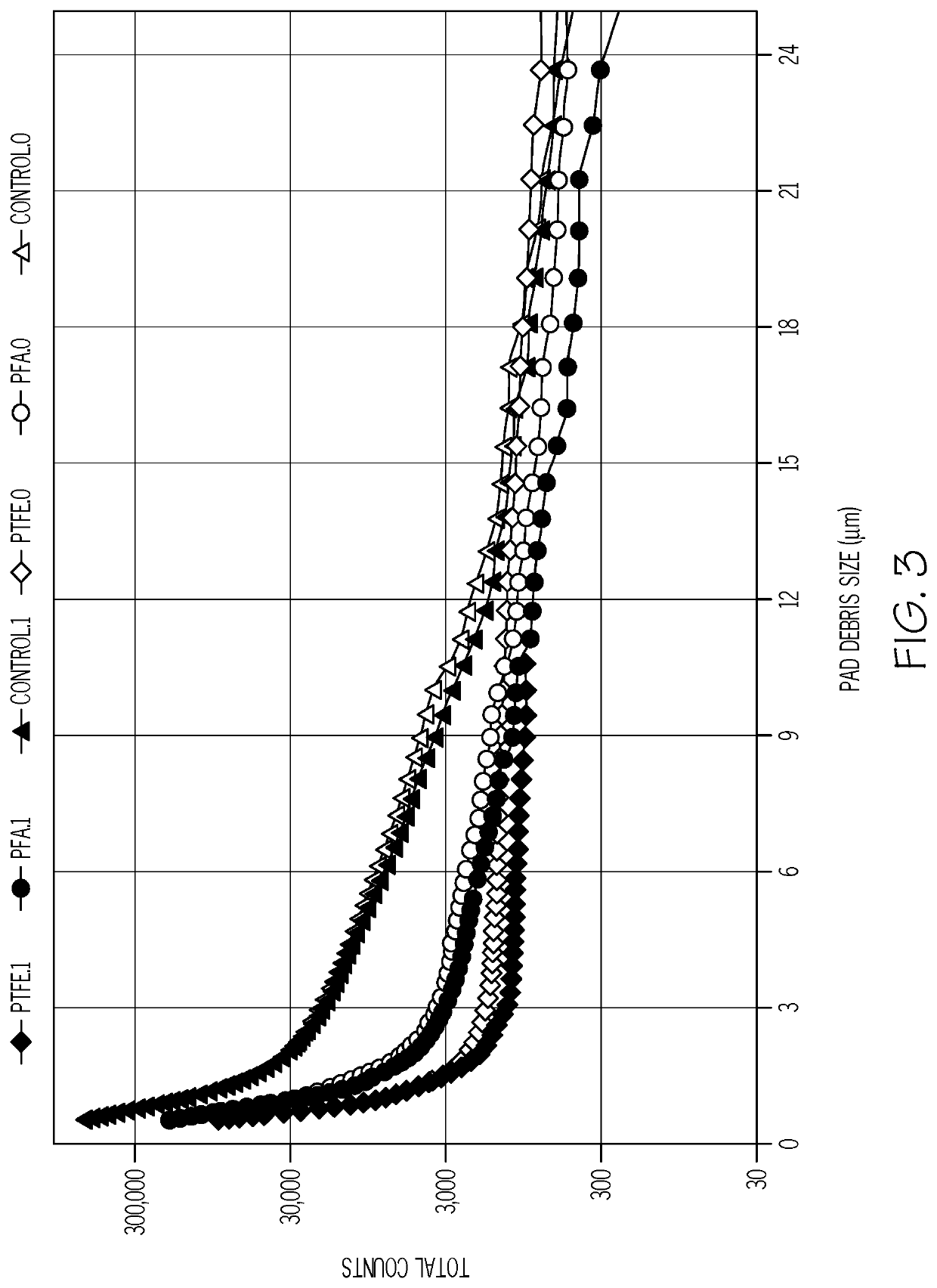Fluopolymer composite cmp polishing method
- Summary
- Abstract
- Description
- Claims
- Application Information
AI Technical Summary
Benefits of technology
Problems solved by technology
Method used
Image
Examples
example 1
[0065]The physical properties of a set of Sample A made with and without the addition of 10 weight percent of PTFE-1 and PFA were conducted. As shown in the Table below, changes of note were the reduction in tensile strength, hardness and the majority of the mechanical properties. Of specific interest was the difference in the effect of additions on the shear storage modulus (G′), which was characteristic of elastic behavior versus the effect on the shear loss modulus (G″), which represents the amount of energy dissipated in the sample. Shear storage modulus G′ at 40° C. showed a significant reduction relative to the control (−31% for PFA and −45% for PTFE). Shear loss modulus, G″ showed a similar trend (−26% for PFA and −37% for PTFE). While all samples were primarily elastic polymers, tan δ, the ratio of G″ to G′, increased by 6% and 14% for PFA and PTFE additions, respectively. This was a direct measure of the increase in the energy dissipation effected by the fluoropolymer addit...
example 2
[0068]The deionized water contact angle was measured on a set of medium porosity polyurethane pads of Sample B that had varying amounts of PTFE-2 added during manufacturing. As shown in FIG. 1, the contact angle increased directly with increasing PTFE content to a steady state value of around 140 degrees by 7.5% PTFE content. All pads with both PTFE and PFA additions were visibly more hydrophobic than the parent pad. Despite this, the polishing surface is hydrophilic as measured with distilled water at a pH of 7 at a surface roughness of 10 μm rms after soaking in distilled water for five minutes.
example 3
[0069]A polishing test was performed on a set of high-strength Sample A pads with and without the addition of PTFE and PFA in order to demonstrate the beneficial effects of the present invention. The concentration of each fluoropolymer added was 8.1%. Three slurries were tested on each pad set using 60 200 mm TEOS monitor wafers per test on an Applied Materials Mirra CMP polishing tool. The slurries used were two ceria slurries (Asahi CES333F2.5 and DA Nano STI2100F) and a fumed silica slurry (Cabot SS25). Conditions used were 3 psi (20.7 kPa) downforce, 93 rpm platen speed, 87 rpm carrier speed, and 150 ml / minute slurry flow. Conditioners varied by slurry type. For the ceria slurries, a Saesol LPX-C4 diamond conditioner disk was used. For the silica slurry, a Saesol AK45 conditioner disk was used. All conditioners were used concurrently with polishing at 7 lb force (3.2 kgf). For each run, a pad break-in conditioning step was used for 20 minutes at 7 lb force (3.2 kgf) to ensure a ...
PUM
| Property | Measurement | Unit |
|---|---|---|
| Temperature | aaaaa | aaaaa |
| Temperature | aaaaa | aaaaa |
| Temperature | aaaaa | aaaaa |
Abstract
Description
Claims
Application Information
 Login to view more
Login to view more - R&D Engineer
- R&D Manager
- IP Professional
- Industry Leading Data Capabilities
- Powerful AI technology
- Patent DNA Extraction
Browse by: Latest US Patents, China's latest patents, Technical Efficacy Thesaurus, Application Domain, Technology Topic.
© 2024 PatSnap. All rights reserved.Legal|Privacy policy|Modern Slavery Act Transparency Statement|Sitemap



